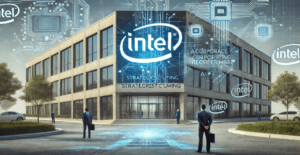Intel Announces Layoffs and Strategic Overhaul Under New CEO Lip-Bu Tan
Intel’s new CEO, Lip-Bu Tan, is implementing major changes, including layoffs, to streamline the company’s operations and improve efficiency. Despite still making profits, Intel recently reported a $1.6 billion loss, prompting restructuring efforts. Tan aims to cut middle management and enhance Intel’s chip manufacturing division, Intel Foundry, by attracting more clients like Microsoft and Amazon. He also plans to focus on AI-powered servers, software, and robotics. Intel suffered a $19 billion annual loss in 2024, its first since 1986.
Tan replaces Pat Gelsinger, who was criticized for being too lenient on management cuts. Gelsinger’s vision was to make Intel a major contract chip manufacturer like TSMC, but economic challenges forced cutbacks. Tan, a former Cadence CEO, previously served on Intel’s board and now seeks to reposition the company for success. His strategy refines, rather than overhauls, Intel’s previous approach. He plans to listen to stakeholders while reshaping the company’s future.

Intel Announces Layoffs and Strategic Overhaul Under New CEO Lip-Bu Tan
Intel is preparing to lay off several employees as part of a major restructuring plan led by its new CEO, Lip-Bu Tan. Facing significant challenges, Tan is stepping in to implement key changes in Intel’s chip manufacturing processes and artificial intelligence (AI) strategy. His goal is to help the company recover from its recent struggles and regain its position as a leading tech giant.
Although Intel remains profitable, it recently reported a $1.6 billion loss, forcing the company to make difficult decisions. One of Tan’s primary objectives is to simplify Intel’s management structure, which he believes has become overly complex and inefficient. To address this, he plans to reduce middle management roles and streamline manufacturing operations.
Historically, Intel primarily produced chips for its own products. However, it has recently expanded to manufacturing semiconductors for other companies, including Nvidia. Tan aims to grow this division, known as Intel Foundry, by attracting more clients such as Microsoft and Amazon. This strategy could help Intel diversify its revenue streams and strengthen its position in the semiconductor industry.
During a recent company meeting, Tan acknowledged that tough choices are necessary to get Intel back on track. Some industry experts believe the company’s former CEO, Pat Gelsinger, was hesitant to make the necessary cuts, which may have contributed to Intel’s current struggles. In contrast, Tan appears ready to take decisive action to turn things around.
Tan, 65, has an extensive background in the tech industry. Before joining Intel, he was the CEO of Cadence, a company specializing in chip design software. He is also a seasoned tech investor and previously served on Intel’s board of directors until resigning in August of last year. Now, as CEO, he faces the challenge of reviving a company that has fallen behind in key areas like AI chips and mobile processors, where competitors such as Nvidia and Arm have taken the lead.
Intel’s financial situation has raised concerns. In 2024, the company reported a staggering $19 billion annual loss—the first since 1986. To address this, Tan plans to focus on strengthening Intel’s chip-making business, expanding into AI-powered servers, and exploring new opportunities in software, robotics, and AI models. These efforts aim to keep Intel competitive in an evolving industry.
An Intel spokesperson stated that Tan will spend time listening to customers, partners, and employees to better understand their needs. He will also collaborate with the leadership team to develop strategies for future success. However, Intel has not shared further details about his plans, and Tan has not been available for interviews.
Rather than completely overhauling former CEO Pat Gelsinger’s strategy, Tan appears to be refining it. Gelsinger’s vision was to position Intel as a major contract chip manufacturer, competing with Taiwan’s TSMC, which produces chips for Apple, Nvidia, and Qualcomm. However, due to declining demand in Intel’s core markets, Gelsinger had to scale back some of these ambitions.
According to sources, Tan was critical of Gelsinger’s execution and is now adjusting Intel’s direction to enhance its competitiveness in the fast-evolving semiconductor industry. By prioritizing efficiency, innovation, and new growth areas, he hopes to lead Intel back to success.
In summary, Intel is undergoing significant changes under its new CEO, Lip-Bu Tan. While the company faces challenges, Tan is committed to simplifying operations, improving manufacturing processes, and exploring new opportunities in AI and other technologies. With his experience and strategic vision, he aims to steer Intel toward a brighter future in the competitive tech landscape.
You must be logged in to post a comment.